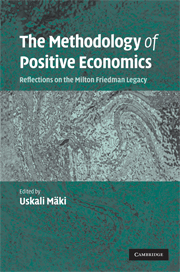Book contents
- Frontmatter
- Contents
- List of figures
- List of tables
- Contributors
- Preface
- Part 1 The classical essay in twentieth-century economic methodology
- Part 2 Reading and writing a classic
- Part 3 Models, assumptions, predictions, evidence
- Part 4 Theoretical context: firm, money, expected utility, Walras and Marshall
- Part 5 Concluding perspectives
- 14 The debate over F53 after fifty years
- 15 Final word
- Index
14 - The debate over F53 after fifty years
Published online by Cambridge University Press: 02 December 2009
- Frontmatter
- Contents
- List of figures
- List of tables
- Contributors
- Preface
- Part 1 The classical essay in twentieth-century economic methodology
- Part 2 Reading and writing a classic
- Part 3 Models, assumptions, predictions, evidence
- Part 4 Theoretical context: firm, money, expected utility, Walras and Marshall
- Part 5 Concluding perspectives
- 14 The debate over F53 after fifty years
- 15 Final word
- Index
Summary
“The methodology of positive economics” (F53) is a classic text in economic methodology and like any classic text it can be read in or out of context. Its original context, as Roger Backhouse reminds us in chapter 8 of this volume, was that of antimarginalist attacks on profit maximization by heterodox economists using survey data to demonstrate that businessmen do not calculate marginal costs and benefits. Much of the essay is easier to understand when we keep that context in mind. But as time passed, that particular context became irrelevant and the essay was increasingly read in the light of Friedman's subsequent career as a monetarist, leading opponent of Keynesian demand management and outspoken advocate of free-market fundamentalism. After, say 1970, few economists could read the essay as simply a methodological defense of patently “unrealistic” assumptions in economic theories because the rest of Friedman's message was always in the back of their minds. In short, in examining interpretations of what F53 really meant, it is important to take account of the year the interpretation is advanced. To underline that point, let me briefly reminisce.
I first read F53 for a 1955 Yale University seminar organized by Tjalling Koopmans when he was writing the second of his Three Essays on the State of Economic Science (1957). Koopmans was quite skeptical of the essay, saying it apologized too much for the lack of realisticness of standard price theory, but I myself, knowing no better, thought it was a remarkably effective defense of standard theory and I was totally convinced by the idea that the assumptions of a theory did not really matter provided the theory predicted accurately.
- Type
- Chapter
- Information
- The Methodology of Positive EconomicsReflections on the Milton Friedman Legacy, pp. 349 - 354Publisher: Cambridge University PressPrint publication year: 2009
- 1
- Cited by



